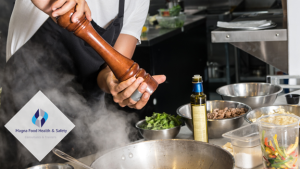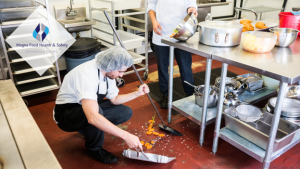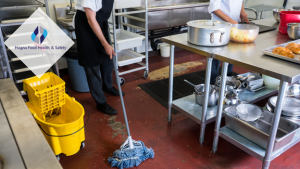10 Jan 2023 Worried About Hygiene Risks? Use This Commercial Kitchen Cleaning Schedule
If you own or manage a commercial kitchen, then you’ll know that ensuring its cleanliness is vital to minimising health and safety risks. However, this doesn’t just mean keeping your equipment in good working order – it also means using the right cleaning products and following the correct procedures every time you clean. If you don’t do this, you can run the risk of fines, loss of reputation and even prosecution.
The risks of insufficient hygiene in commercial kitchens
There are many risks associated with poor sanitation practices in a kitchen environment. The most obvious of these is food poisoning, which causes illness and possible death if not treated properly. Poor levels of cleanliness can cause a restaurant to lose customers, suffer pest infestations and receive complaints from diners about low standards.
UK laws surrounding cleaning practices for commercial kitchens
You must keep your premises clean to protect food from pathogens and provide safe, hygienic dining for customers; you have a responsibility to your customers and employees to keep things clean. The Food Safety Act of 1990 requires that the premises are “kept so as to prevent contamination or deterioration of food”.
Under HACCP, it’s a legal duty to have an effective food safety management system in place. A cleaning schedule is one way of fulfilling this requirement—and the benefits go beyond just meeting legal obligations.

Following this cleaning schedule will help you minimise food hygiene risks
A cleaning checklist can help you see exactly what’s been done, who did it and when. It increases levels of accountability and acts as due diligence evidence if ever required. It also proves that proper cleaning procedures have been followed in the event of a food safety inspection.
Daily cleaning checklist for commercial kitchens
Use this checklist to help you remember the daily cleaning tasks that need your attention. These tasks involve cleaning high-touch surfaces and other areas that get a lot of traffic, where dirt, grime and bacteria can build up if not cleaned properly.
After each use/as required:
- Clean food preparation areas with anti-bacterial cleaner between tasks
- Sanitise all chopping boards and surfaces
- Wash the meat and cheese slicer
- Mop up any spillages immediately
- Wash can openers
- Clean knives and cutlery
- Clean plates
- Wash all utensils and glassware
- Wash cookware
- Wash the heads of the beverage dispenser
- Wipe down equipment, including microwave, toaster and kettle
- Sweep storage areas and walk-in refrigerator
- Refill soap dispensers and paper towels
- Empty bins once they are full AND at the end of the day
- Clean out sinks

At the end of the day/shift:
- Change grill linings
- Clean out the sinks
- Wipe down dishwasher
- Disinfect door handles and light switches
- Disinfect waste areas at the end of the day
- Brush and clean the grill and griddle
- Clean the flattop
- Clean out fryers
- Sweep and mop the kitchen flooring
- Wash any floor mats
- Wash all aprons and chef hats
- Clean hood filters
- Wipe walls that have been splashed
- Clean inside microwave
Weekly cleaning checklist for commercial kitchens
Now that you understand the daily cleaning tasks, it’s time to create a weekly checklist.
These duties include:
- Disinfect sink areas and clean plug and overflow
- Clean ovens, including racks and doors
- Sanitise walk-in areas
- Clean drains with chemical drain cleaners
- Clean out and disinfect all fridges and freezers
- Clean the deep fryer
- Clean coffee makers.
Clean grease traps. - Dust light fixtures.
- Wipe down doors and cabinets
- Clean inside dishwasher
Monthly cleaning checklist
So what should be on your monthly checklist? Completing these tasks each month will help you maintain a high level of hygiene.
Monthly cleaning tasks include:
- Degrease under and behind ovens and fryers
- Clean underneath any appliances and other surfaces
- Disinfect and clean out ice machines
- Disinfect dry storage areas
- Wipe down all walls, ceilings and surfaces with a degreaser and disinfectant
- Clean out coffee and drinks machines with professional cleaning products
- Clean vent hoods
- Clean fridge coils
- Check and change pest traps
- Clean inside dishwasher
- Check cleaning inventory
- Refill first aid box
Checklist of products and equipment needed for cleaning commercial kitchens:
- Degreaser
- Food-safe antibacterial cleanser
- Commercial Disinfectant
- Washing up liquid
- Hand soap
- Dishwasher detergent, salt and rinse aid
- Beverage machine cleaners
- Drain cleaners
- Window cleaning supplies
- Broom
- Dustpan and brush
- Mop and bucket
- Rubber gloves
- Microfibre cloths and paper towels
- Cloths
- Blue roll
- Sponges, scrubbing pads and scourers
- Griddle brush

If you’re looking to avoid fines, loss of reputation and prosecution, then this cleaning schedule is the best way to minimise hygiene risks and keep your business safe. It’s important to remember that this is just a general cleaning schedule and you may need to adapt it depending on the size of your business, how often you use certain areas and any additional requirements from local authorities in terms of food safety. If you have questions about what cleaning products are suitable for certain tasks or have other cleaning requirements, email us today.
Our Food Hygiene Training Courses ensure that food handlers have a comprehensive knowledge of all safety and hygiene procedures.










